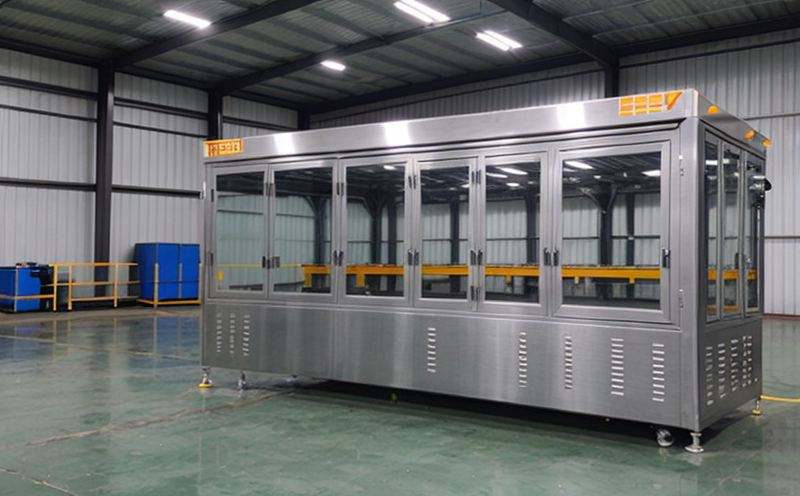ISO 6892-4 Tensile Test of Steel Foils
The ISO 6892-4 tensile test is a crucial procedure for evaluating the mechanical properties, specifically strength and ductility, of steel foils used in metal packaging. This method is particularly vital for ensuring that packaging materials meet quality standards critical to product safety and shelf life.
Steel foils are widely employed in packaging due to their excellent barrier properties against gases, moisture, and light. The tensile test helps determine the optimal thickness of these foils by measuring how they deform and break under controlled stress conditions. This information is essential for designing packaging that meets both functional and regulatory requirements.
During this process, a sample cut from the steel foil is clamped into a testing machine designed to apply tension at a constant rate until failure occurs. The test measures the load required to initiate yielding (yield strength) and ultimately break the material (ultimate tensile strength). Additionally, it evaluates elongation before fracture (ductility), which indicates how plastically the material deforms before breaking.
Understanding these properties ensures that packaging provides adequate protection for the product while also being cost-effective. In metal packaging manufacturing, this test is one of many quality assurance steps aimed at delivering reliable and safe products to consumers.
The precision and accuracy of ISO 6892-4 testing are paramount in ensuring compliance with international standards like ISO 15017 for tensile testing machines. Properly conducted tests provide critical data that helps manufacturers optimize their processes, ensuring consistent quality across batches and production runs.
For quality managers, this test serves as a key indicator of the performance capabilities of steel foils used in packaging applications. It is also valuable for R&D engineers to understand material behavior under stress and to innovate new formulations or modifications that enhance performance without compromising safety.
Compliance officers rely on these tests to ensure that all products meet regulatory requirements set forth by bodies such as the FDA, EMA, and other national authorities responsible for food safety. By adhering strictly to ISO 6892-4 standards during production, companies can demonstrate their commitment to maintaining high-quality packaging that protects consumer goods effectively.
Applied Standards
The ISO 6892 series provides comprehensive guidance on mechanical testing of metals and alloys. Specifically, the tensile test specified in ISO 6892-4 is widely recognized for its reliability across various industries where metal foils are used.
- ISO 15017: This international standard sets out specifications for tensile testing machines used in materials science. Compliance with these standards ensures that the equipment employed during ISO 6892-4 tests operates accurately and consistently, thereby producing reliable results.
- ASTM E8: American Society for Testing and Materials' E8 standard covers procedures for tensile testing metals. While not identical to ISO 6892, it offers complementary methods that can be utilized alongside the international standard when necessary.
- EN 10007-1:2015: European Norms provide additional context on tensile testing for specific applications within Europe. Understanding these standards complements global practices and ensures uniformity across different regions.
The combination of these standards provides a robust framework for conducting accurate tensile tests, ensuring that results are consistent, reproducible, and comparable internationally.
International Acceptance and Recognition
The ISO 6892-4 standard has gained widespread acceptance across numerous industries globally. Its rigorous approach to tensile testing of metals ensures that results are reliable and universally applicable, making it a preferred choice for laboratories around the world.
Regulatory bodies like the FDA in the United States and EMA in Europe often mandate compliance with ISO standards when assessing packaging materials for food contact surfaces. This alignment encourages manufacturers to adopt these methods as part of their quality assurance protocols.
The international recognition extends beyond regulatory requirements into academic research and industrial best practices. Many leading universities incorporate ISO 6892-4 methodologies into their curricula, fostering a standardized methodology that benefits future professionals entering the field.
Manufacturers adopting this standard not only enhance their reputation but also gain access to broader markets where these stringent quality controls are valued. By demonstrating adherence to such recognized international standards, companies can build trust with stakeholders and consumers alike.
Use Cases and Application Examples
| Use Case | Description |
|---|---|
| Packaging Design Optimization | Determining the optimal thickness of steel foils ensures that packaging provides sufficient protection while minimizing material costs. |
| Quality Assurance | Regularly testing samples helps identify any inconsistencies in production, ensuring batch-to-batch consistency. |
| New Material Development | Evaluating experimental materials against established standards provides valuable insights into their suitability for packaging applications. |
| Compliance Verification | Ensuring compliance with regulatory requirements by conducting tests that meet international standards. |
- Packaging Design Optimization: By measuring the tensile properties of different foil thicknesses, designers can select the most appropriate material for their needs without over-engineering or underperforming.
- Quality Assurance: Continuous monitoring through periodic testing ensures that each batch meets specified quality criteria, reducing defects and recalls.
- New Material Development: Researchers use these tests early in development to identify promising materials quickly and adjust formulations accordingly.
- Compliance Verification: Companies must verify compliance with relevant regulations by performing tests that align closely with internationally recognized standards like ISO 6892-4.
The table above highlights key areas where tensile testing plays a critical role in the packaging industry. These applications underscore why this test remains essential for maintaining high-quality metal foils suitable for various packaging needs.





